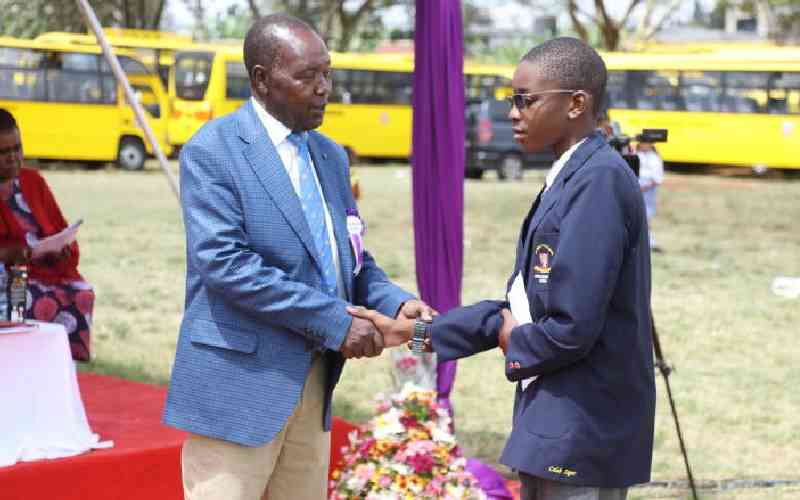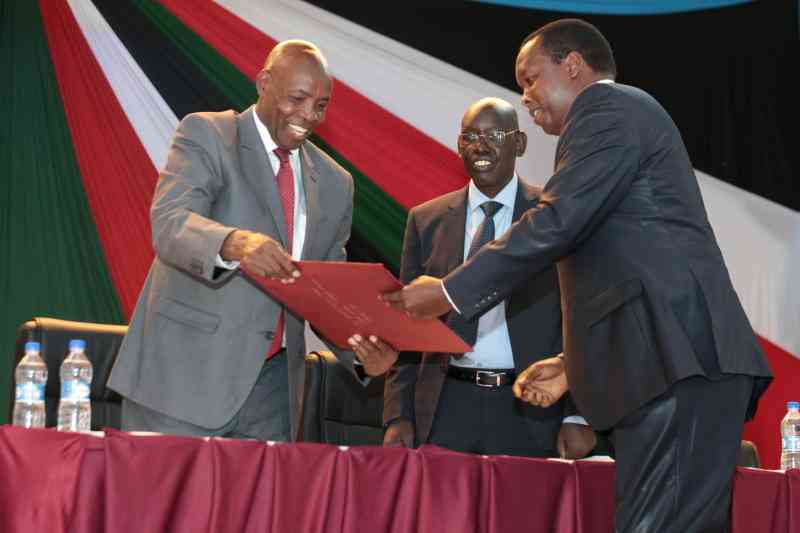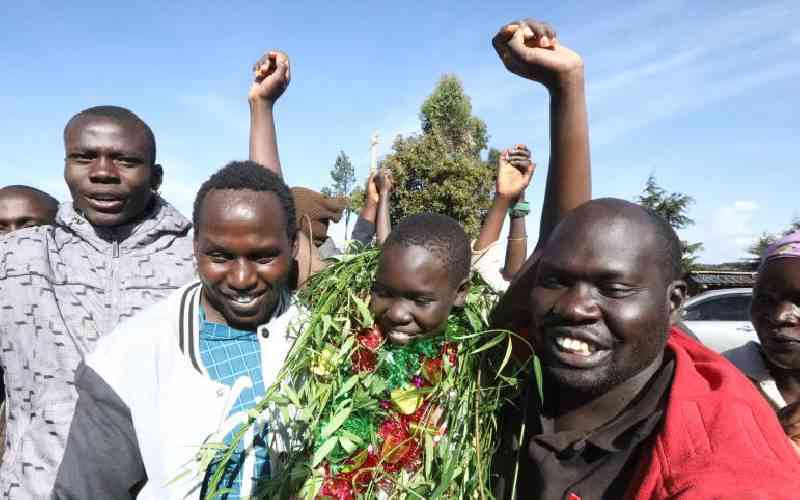 |
|
Chianda Secondary School student Derrick Ambani selects books at Vaghela Bookshop in Kakamega, ready to return to school. [Photo: Benjamin Sakwa/Standard] |
There are more national school slots up for grabs in Form One admissions this year, but the dominant news in the education sector remains the outcry by private academies against what they see as discriminatory and unfair treatment favouring candidates from public schools.
Whereas it is Government policy to favour children from public schools — because they lack resources and the institutions are the lifeline of poor families — private schools believe their success and heavy financial investment has been used against them.
Sunday, the Kenya Private Schools Association (KPSA) maintained its opposition to the Form One selection criteria arguing it discriminated against candidates from private schools.
The association spoke ahead of Tuesday’s launch of the 2015 Form One intake by Education Cabinet Secretary Jacob Kaimenyi. KPSA Chief Executive Peter Ndoro explained they would not accept the selection of students based on schools they attended, adding that they were not opposed to the selection of students based on the quota system as long as the interest of the pupil was upheld and not the school’s.
“We are opposed to disproportionate selection that looks at a student as coming from a public or private schools. We want selection based on the needs of students,” argued Ndoro.
Ndoro then dropped the warning that KPSA would consider withdrawing their schools from being examination centres and just let them be learning centres, meaning the candidates would then have to be registered elsewhere.
“We shall never support Government’s idea of discriminating children by listing them as public or private. Kaimenyi has refused to speak to us but if this formula remains discriminatory, we shall convert private schools into teaching centres and let Government schools offer exams,” cautioned Ndoro.
Ndoro argued that last year students from private schools were allocated 4,000 places in national schools against 17,000 available slots which translates to only about 25 per cent allocation.
But a ministry official who declined to be named explained that the Government had increased slots for candidates from private schools.
“Previously they selected four candidates per sub-county (formerly districts) that is a top boy and girl,” he said and added: “This has been revised to six or three top performers for each gender.”
Limited positions
But competition for the limited positions will be stiff among qualified candidates who sat last year’s Kenya Certificate of Primary Education (KCPE). The increase of national schools from 78 to 102 means that this year there will be some 4,000 additional slots.
Last year, there were 16,000 positions but this year top performers will battle it out for 20,603 slots in national schools.
The additional places arose after elevation to national status of former extra county schools - top performing schools selected based on track record and national spread. It means that each county has at least two national schools.
Prof Kaimenyi launches the selection exercise tomorrow at the Kenya Institute of Curriculum Development to place students in national, county and sub-county schools.
Stay informed. Subscribe to our newsletter
The selection to determine slots available in other categories will be completed by tomorrow, a top official told The Standard.
The launch of County Form One selection is planned for January 26 and 27 and the exercise will be concluded on January 29 with admissions into sub-county schools.
Last year while announcing KCPE results, the Government did not release performance rankings for the more than 880,000 candidates who wrote the examination last year.
Out of 880,486 candidates, some 687,000 - representing about 78 per cent- will join secondary schools but 193,486 will join growing statistics of those who drop out.
The selected students are expected to report to secondary schools between February 2 and 13.
The Form One selection intake entails the admission into either national, county or district day schools depending on the candidate’s school choices.
National Schools are distributed both based on candidature and affirmative action which is intended to enable each district to get a candidate selected to a national school, while the national school quota is used to select candidates per gender and merit list per district.
The cut-off mark to each national school is automatically determined based on the last candidate to be selected to a given national school from a given district in a county.
The selection will be based on a 40 per cent national, 40 per cent to districts within county and inclusive home district of the school, 20 per cent for home and host district of the school. However, not all county schools can attract national quota and may be allocated quotas to only districts within host county.
Ministry of Education Public Relations Officer Kennedy Buhere explained that the procedure for the selection in tomorrow’s exercise will include the picking of the top two candidates for both boys and girls to their national school of choice if an allocation has been provided for their district.
In absence of such, the computer automatically assigns such candidates schools of equal stature to their choices and selection of other national schools quota based on candidates ratio from public and private schools.
The system gives advantage to counties in filling vacancies that may arise during the selection, where a district is unable to produce candidates with more or equal to 280 marks.
Speaking to The Standard via telephone, Mr Buhere said district selection will still be done manually due to challenges of mapping primary schools or communities to proximity of secondary day schools.
Transition rate
It is expected the selection results shall be accessed online in the Ministry of Education portal by the public and the successful candidates. Unsuccessful candidates will get feedback on their application based on the quotas already computed which will be shared out soon.
Kenya National Union of Teachers Secretary General Wilson Sossion challenged Kaimenyi to ensure the Government increased allocation to the education sector if the transition rate is to be boosted.
Sossion argued that Kenya still lags behind Rwanda, Ghana, South Africa and other African countries on transition rate that could be improved if the Government allocates about 32 per cent of the national budget to education.
“It is the failure of the Government to use affirmative action and the quota system during any selection. It is true that a pupil in public school cannot compete with a pupil from private school because of many reasons. But this is a Government failure. They have failed pupils in public schools,” said Sossion.
 The Standard Group Plc is a
multi-media organization with investments in media platforms spanning newspaper
print operations, television, radio broadcasting, digital and online services. The
Standard Group is recognized as a leading multi-media house in Kenya with a key
influence in matters of national and international interest.
The Standard Group Plc is a
multi-media organization with investments in media platforms spanning newspaper
print operations, television, radio broadcasting, digital and online services. The
Standard Group is recognized as a leading multi-media house in Kenya with a key
influence in matters of national and international interest.
 The Standard Group Plc is a
multi-media organization with investments in media platforms spanning newspaper
print operations, television, radio broadcasting, digital and online services. The
Standard Group is recognized as a leading multi-media house in Kenya with a key
influence in matters of national and international interest.
The Standard Group Plc is a
multi-media organization with investments in media platforms spanning newspaper
print operations, television, radio broadcasting, digital and online services. The
Standard Group is recognized as a leading multi-media house in Kenya with a key
influence in matters of national and international interest.









